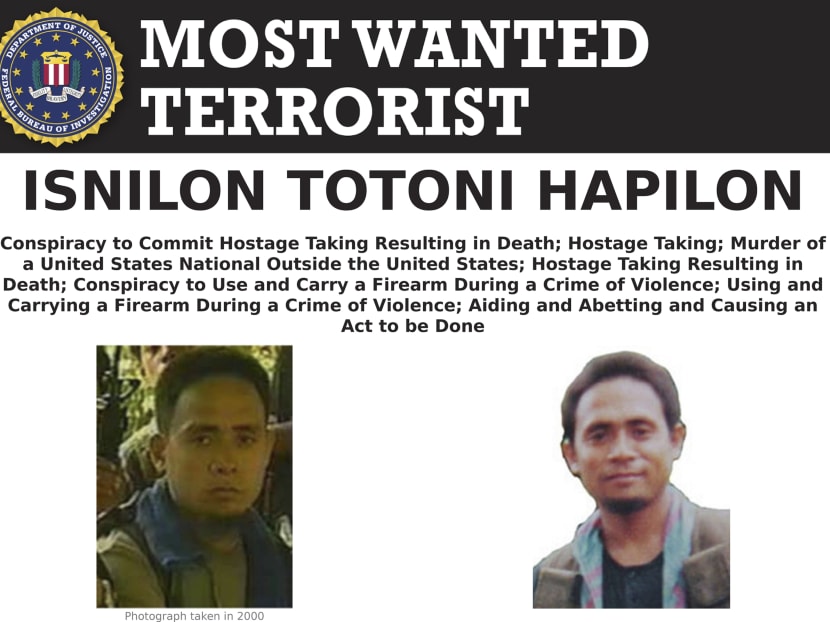IS remains a threat to South-east Asia despite leader’s death: Analysts
KUALA LUMPUR — The reported death of Islamic State’s (IS) top leader in South-east Asia is a major blow to the jihadists but analysts warn it remains a potent threat, with battle-hardened fighters set to return from the Middle East.

This undated file image provided by the Federal Bureau of Investigation shows a wanted poster for Isnilon Hapilon. Photo: FBI via AP
KUALA LUMPUR — The reported death of Islamic State’s (IS) top leader in South-east Asia is a major blow to the jihadists but analysts warn it remains a potent threat, with battle-hardened fighters set to return from the Middle East.
IS’ regional head Isnilon Hapilon was said to have been killed early Monday (Oct 16) in the southern Philippines during a military offensive to end the months-long siege of the city of Marawi, which has cost hundreds of lives.
The military said the leader - who was on the United States’ “most wanted terrorists” list - died in a dawn offensive alongside Omar Maute, who allied with Hapilon to plot the takeover of the city.
IS-supporting gunmen had overrun the predominantly Catholic country’s main Muslim city in May following a foiled attempt by security forces to arrest Hapilon.
Hapilon, a key figure in Philippine kidnap-for-ransom outfit Abu Sayyaf, emerged as leader of IS in South-east Asia in 2016 when a video appeared showing militants from the group urging extremists to unite under his leadership.
Omar Maute was a leader of the Maute group, a ragtag outfit that emerged from a decades-old Muslim separatist rebellion on the southern island of Mindanao. His group also pledged allegiance to IS and joined forces with Hapilon to overrun Marawi.
Hapilon and Maute were the final two extremist leaders holding out against a military offensive to oust the militants from Marawi. Last month Abdullah Maute - another key leader of the Maute group and Omar’s brother - was killed in fighting.
Hapilon was key to IS’ efforts to establish a base in South-east Asia as the jihadists increasingly lose ground in the Middle East. His reported killing is undoubtedly a blow for the jihadists, analysts said.
SYMBOLIC BLOW
His death is “a significant operational and symbolic blow to IS-linked groups in Mindanao and to IS Central in Syria as well”, said Professor Kumar Ramakrishna, a terrorism expert from Singapore’s S. Rajaratnam School of International Studies, using another name for the group.
But he cautioned that it was far from the end of IS in the strife-torn southern Philippines or South-east Asia.
“Just because the Marawi siege is coming to an end does not mean the threat is over. IS-linked militants there will regroup... and lay low for a while, while rebuilding their strength,” he said.
He said a Malaysian militant involved in the Marawi siege, Mahmud Ahmad - would if he is still alive likely rise up to lead the IS-linked fighters in the southern Philippines and stay in contact with the jihadists in the Middle East.
Mahmud Ahmad is reported to be a university lecturer in his home country who was in charge of raising finances from abroad for the jihadists and recruitment.
It is not clear how many IS-supporting militants there are in South-east Asia, a region of more than 600 million people, but many local militant outfits have pledged allegiance to the group.
Hundreds of militants are believed to have flocked to the Middle East to fight with IS - particularly from Indonesia, which has the world’s biggest Muslim population, and the Philippines.
Ms Sidney Jones, head of Jakarta-based security think-tank the Institute for Policy Analysis of Conflict, warned authorities now faced a growing threat of battle-hardened fighters returning to South-east Asia as the noose closes on IS in the Middle East, with their former stronghold of Raqqa close to being captured.
Authorities have been particularly concerned about a South-east Asian unit of IS fighters in Syria, Khatibah Nusantara.
“I think the attention is going to shift back again to the return of fighters from Syria and Iraq,” she said. AFP






